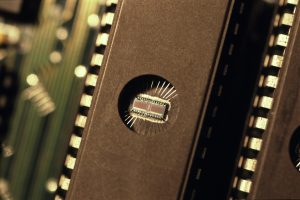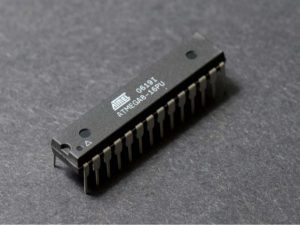EEPROM

An EEPROM chip on a computer motherboard.
Also known as “electrically erasable programmable read only memory”, EEPROM is more of an integrated circuit that can be configured by different device programmers. Just like a ROM chip EEPROM utilizes electrical impulses and grid for the creation of binary data. The only difference between EEPROM chip and a ROM chip lies in the fact that EEPROM chips can be passed through a programming process without actually getting them removed from the computer. For the erasing of the EEPROM chip all you need to do is to treat it with a localized charge. You do not need to erase the chip, one time.
Different Types Of EEPROM
Nowadays due to advancement in technology several different kinds of EEPROM chips have been produced by creative minds working all over the world. The parameters on which the majority of chip types have their basis on are things like maximum cycle time, memory organization, maximum clock frequency and type of packaging.
Types Of Memory

A Parallel EEPROM Device.
The EEPROM consists of the following memories:
- The first type of EEPROM memory is known as Parallel EEPROM Memory. The parallel memory basically consists of a bus which has a width of 8 bit. This width assists it in the covering of entire memory of various processor applications which are small. Most parallel devices have written and select protect pins.
- The second type is known as Serial EEPROMS and this type of memory is a little difficult to operate. The difficulty lies in the fact that pins are fewer and operations need to be performed in a manner which is serial in nature
The Programming Methodology
A plain or normal EEPROM has to be completely erased before it can pass through reprogramming process. The programming of EEPROM is very simple and according to many it is one of the easiest chips to understand and learn about. EEPROM have not been designed in a way that they be programmed via hand. It is advisable that EEPROMS need to be programmed through a chip burner. EEPROM consists of 3 different pins. The names of these pins are
- The first pin is OE which helps the chip in getting a byte output
- The second pin is called WE which helps in the programming of the byte
- The third pin is known as CE which helps in the activation of the chip
The Three Key steps
- First of all get your EEPROM turned on. Once this is done connect the power pins with the power supply
- The most important step is to get the byte programmed. First of all get the EEPROM’S address configured. Secondly configure the data buses so that the byte you want to get stored gets indicated.
- Get the WE pin cycled so that the byte may be written. It is recommended that you should slow down WE and also make it high again. If you see that the EEPROM is operating perfectly then understand that you have actually stored the byte. You can further examine the phenomenon through OE.
The programming procedure of EEPROM is not that difficult however the process involves several technical details as well. If you are interested and want to know more about EEPROM then it is recommended that you should click this one by radio-electronics.






Comments are closed.